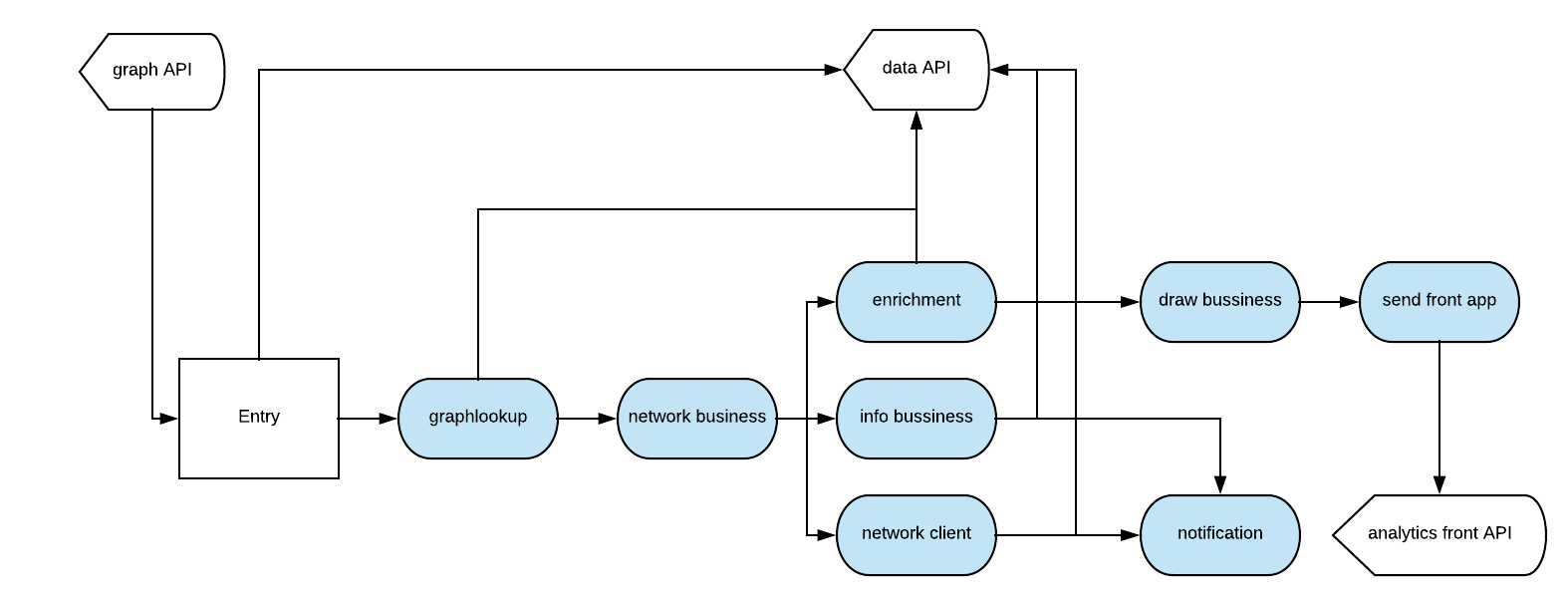Analytics Maestro¶
Analytics App is a module to analytics graph and create xml of Maestro Server, yours responsibility is:
- Create grids
- Create bussiness graph
- Create network graph
- Create infra graph
- Drawing
- SVGs

Analytics using Flask, and python >3.5, has api rest, and tasks.
Setup dev env
cd devtool/
docker-compose up -d
Will be setup rabbitmq and redis
Windows Env
If you use windows, celery havent support for windows, the last version is 3.1.25.
pip3 install celery==3.1.25
npm run powershell
Important topics
Controller used only graph to start all tasks:
The drawer process is compound by:
entry: First task, figure out all entry applications accordingly system endpoint parameters, our any direct application if avalaible.
graphlookup: Request for Data App a aggregate query using MongoDB $graphLookup.
network bussiness: Construct Grid Map, and send to enrichment and info bussines.
enrichment: Request for Data App all servers used on grid.
info bussiness: Calculate histogram, counts, density and connections.
network client: Request for Data App all clients used in grid.
draw bussiness: Create svgs based of grid.
notification: Send updates for Data App.
send front app: Send svgs to Analytics Front app.
Each step have unique task.
Config is managed by env variables, need to be, because in production env like k8s is easier to manager the pods.
Repository has pymongo objects.
Flower - Debbug Celery
You can install a flower, it’s a control panel to centralize results throughout rabbitMQ, very useful to troubleshooting producer and consumers.
pip install flower
flower -A app.celery
npm run flower
Installation with python 3
- Python >3.4
- RabbitMQ
Download de repository
git clone https://github.com/maestro-server/discovery-api.git
Install dependences
pip install -r requeriments.txt
Install run api
python -m flask run.py
or
FLASK_APP=run.py FLASK_DEBUG=1 flask run
or
npm run server
Install run rabbit workers
celery -A app.celery worker -E -Q analytics --loglevel=info
or
npm run celery
Warning
For production environment, use something like gunicorn.
# gunicorn_config.py
import os
bind = "0.0.0.0:" + str(os.environ.get("MAESTRO_PORT", 5020))
workers = os.environ.get("MAESTRO_GWORKERS", 2)
Env variables
| Env Variables | Example | Description |
|---|---|---|
| MAESTRO_PORT | 5020 | Port |
| MAESTRO_DATA_URI | http://localhost:5010 | Data Layer API URL |
| MAESTRO_ANALYTICS_FRONT_URI | http://localhost:9999 | Analytics Front URL |
| MAESTRO_WEBSOCKET_URI | http://localhost:8000 | Webosocket App - API URL |
| MAESTRO_SECRETJWT_PRIVATE | XXX | Secret Key - JWT private connections |
| MAESTRO_NOAUTH | XXX | Secret Pass to validate private connections |
| MAESTRO_WEBSOCKET_SECRET | XXX | Secret Key - JWT Websocket connections |
| MAESTRO_GWORKERS | 2 | Gunicorn multi process |
| CELERY_BROKER_URL | amqp://rabbitmq:5672 | RabbitMQ connection |
| CELERYD_TASK_TIME_LIMIT | 10 | Timeout workers |